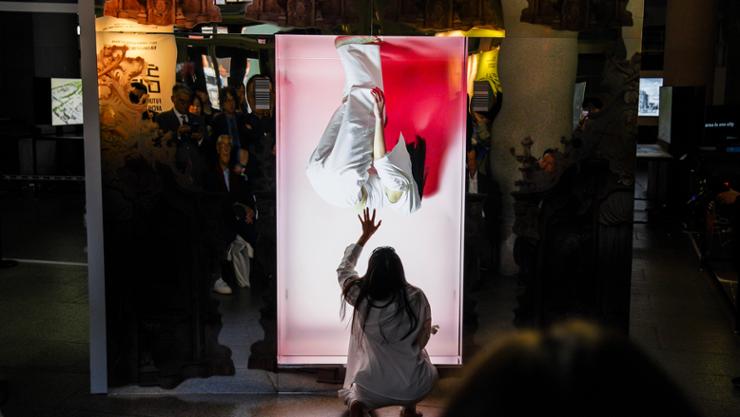Interactive media installation performance titled “Future Transformation: Digital Confession” by media artist Lee Kyung-hwa, staged during the opening ceremony of the 2023 Korean Institute of Architects (KIA) Convention & Exhibition, Oct. 25, 2023, at Culture Station Seoul 284. Courtesy of the artist
By Park Han-sol
At the commencement of the Korean Institute of Architects (KIA) Convention & Exhibition on October 25 last year, an artist concealed within a life-size, glass-encased container at Culture Station Seoul 284 captivated the onlookers.
Cloaked in all-white attire, she moved with deliberate and expressive motions within the boundaries of the enclosed space. However, just as the audience acclimated to observing her movements within the enclosure, the genuine performer materialized before their eyes, seemingly appearing out of thin air.
It didn’t take long for the audience to discern that what they had been witnessing was, in reality, a hyper-realistic holographic representation of the dancer, projected onto a digital display, rather than her physical presence.
She proceeded to approach the screen, coming face-to-face with her virtual “body double” accompanied by compelling music.
The spectacle eventually adopted an interactive approach as the audience was encouraged to enter the holographic realm, don a 3D-printed mask, and assume the role of protagonists in the presentation.
The brainchild behind this media installation performance, “Future Transformation: Digital Confession,” is media artist Lee Kyung-hwa.
“In conceptualizing the enclosed space in the installation (where the holographic image is projected), I aimed for a contemporary and open rendition of a confession booth,” Lee expressed in a recent email interview with The Korea Times. “Here, where media art intersects with architecture, my intention was to unveil one’s intimate desires and physical nature conveyed through movements using today’s digital technology.”
As the spectators are given the opportunity to behold their own holographic likenesses, they embark on contemplating the association between their physical selves, bound by everyday realities like climate change and economic status, and their virtual counterparts seemingly unaffected—perhaps even liberated—from these pressing concerns.
Media artist Lee Kyung-hwa / Korea Times photo by Shim Hyun-chul
“Future Transformation: Digital Confession” is an extension of Lee’s continual examination into how the advent of digital technology—including 3D printing and virtual reality—has induced a transformative shift in the way human beings perceive their physical bodies and, in addition, the spatial surroundings encasing them.
Her previous prominent project, “Malleable Bodies,” showcased at the National Museum of Modern and Contemporary Art, Korea (MMCA) Seoul in 2015 and at REDCAT in Los Angeles in 2018, visualized the notion that our bodies are no longer perceived as unalterable entities.
“Today’s 3D printing has the capability to create even skin tissues and organs. It occurred to me that with such technological progress, the human body has transformed into an architectural space that can be molded and designed at will,” the artist remarked.
“This paradigm is particularly noteworthy in Korea, where for centuries, it was believed that the bodies we inherited from our parents were unchangeable.”
Her latest performance expands on this concept to underscore that today, bodies can experience not just substantial physical alterations, but also subsist in an entirely virtual, intangible state.
Culture Minister Yoo In-chon, one of the VIP attendees of the 2023 Korean Institute of Architects (KIA) Convention & Exhibition, makes a holographic appearance as part of Lee Kyung-hwa’s “Future Transformation: Digital Confession,” Oct. 25, 2023. Courtesy of the artist
Looking ahead, Lee, who also serves as the international director of the Nam June Paik Cultural Foundation, is endeavoring to contemplate the future trajectory of Korea’s media architecture, drawing inspiration from and reinterpreting the inventive essence of Paik—a prominent figure in artistic experimentation.
She is also devising an exhibition in which architects and other creatives can collaborate to bring alternative and experimental perspectives to the forefront.
“In an era where we can fabricate a reality seemingly indistinguishable from the physical one, I aim to delve into further possibilities we can construct,” she voiced.
! function(f, b, e, v, n, t, s) {
if (f.fbq) return;
n = f.fbq = function() {
n.callMethod ?
n.callMethod.apply(n, arguments) : n.queue.push(arguments)
};
if (!f._fbq) f._fbq = n;
n.push = n;
n.loaded = !0;
n.version = ‘2.0’;
n.queue = [];
t = b.createElement(e);
t.async = !0;
t.src = v;
s = b.getElementsByTagName(e)[0];
s.parentNode.insertBefore(t, s)
}(window, document, ‘script’,
‘https://connect.facebook.net/en_US/fbevents.js’);
fbq(‘init’, ‘2240470362946308’);
fbq(‘track’, ‘PageView’);
